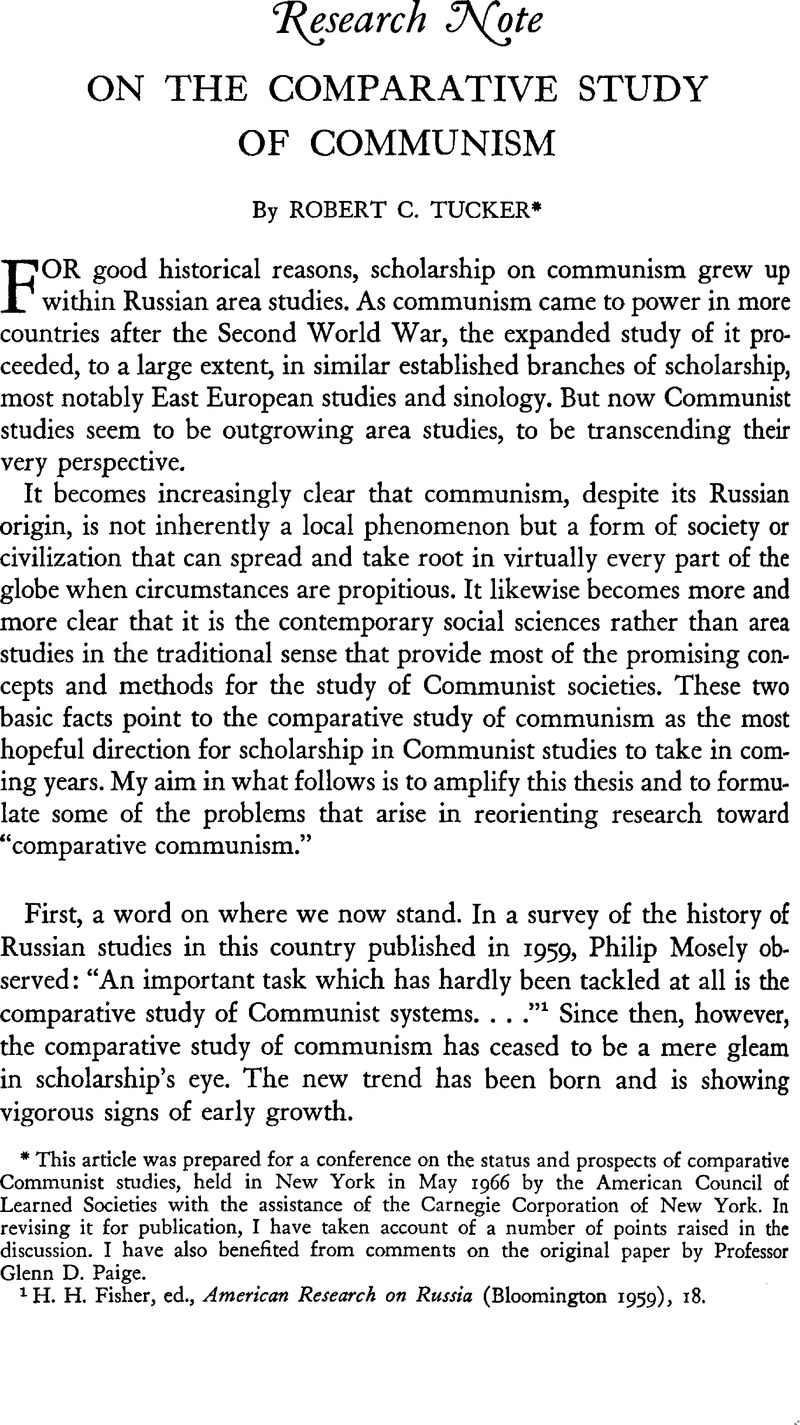Article contents
On the Comparative Study of Communism
Published online by Cambridge University Press: 18 July 2011
Abstract

- Type
- Research Note
- Information
- Copyright
- Copyright © Trustees of Princeton University 1967
References
1 Fisher, H. H., ed., American Research on Russia (Bloomington 1959), 18Google Scholar.
2 Why Lenin? Why Stalin? (Philadelphia and New York 1964Google Scholar).
3 The Dynamics of Modernization (New York 1966Google Scholar).
4 “The Chinese Revolution in Russian Perspective,” World Politics, xiii (January 1961), 210Google Scholar–30.
5 (Stanford 1962).
6 See, for example, David Granick's “An Organizational Model of Soviet Industrial Planning,” Journal of Political Economy, LXVII (April 1959), 109Google Scholar–30; Gregory Grossman's “Notes for a Theory of the Command Economy,” Soviet Studies (October 1963); and Montias', John“Planning with Material Balances in Soviet-Type Economies,” American Economic Review, XLIX (December 1959), 963Google Scholar–85.
7 Law and Contemporary Problems, xxx (Spring 1965), 270–90.Google Scholar
8 (Cambridge, Mass., 1960; rev. ed. New York 1961).
9 (Princeton 1961).
10 (New York 1963).
11 (Englewood Cliffs 1965).
12 New York 1966).
13 Treadgold, Donald, “The Two Communist Giants Compared: A Report of the Conference on Soviet and Chinese Communism,” ACLS Newsletter, xvi (November 1965), 1–4.Google Scholar
14 Alfred Meyer, “The Nature of Communist Systems,” a paper prepared for presentation at the Midwest Political Science Conference, Chicago (April 1966), mimeographed. For a much earlier criticism of the same kind and a plea for comparativism, see Skilling, H. Gordon, “Soviet and Communist Politics: A Comparative Approach,” Journal of Politics, xxn (May 1960), 300–313CrossRefGoogle Scholar.
15 Johnson, Chalmers, “The Role of Social Science in China Scholarship,” World Politics, xvii (January 1965), 256CrossRefGoogle Scholar–57.
16 Campbell, Robert W., “On the Theory of Economic Administration,” in Rosovsky, Henry, ed., Industrialization in Two Systems: Essays in Honor of Alexander Gerschenkron (New York 1966Google Scholar).
17 (New York 1938).
18 (Princeton 1956).
19 “The Non-Ruling Communist Parties: National or Cross-National? Prospectus for a Symposium,” Stanford Studies of the Communist System (June 1965), mimeographed.
20 See Brzezinski, Zbigniew, “The Nature of the Soviet System,” Slavic Review, xx (October 1961), 351CrossRefGoogle Scholar–68.
21 Tucker, Robert C., “Towards a Comparative Politics of Movement-Regimes,” American Political Science Review, LV (June 1961), 281–89. On “mobilization systems”Google Scholar see David Apter, The Politics of Modernization (Chicago 1965). For a review oi the recent criticisms of the concept of totalitarianism, see Skilling's “Interest Groups and Communist Politics,” World Politics, xvm (April 1966), 435Google Scholar–51.
22 (Cambridge 1960).
23 See, for example, Gabriel A. Almond and James S. Coleman, eds., The Politics of the Developing Areas (Princeton i960). The concept of totalitarianism may have been an inhibition upon comparative treatment of non-Communist and Communist “developing areas.” Thus in an earlier fourfold classification of political systems, Almond characterized the developing countries under the heading of “pre-industrial political systems” while placing communism in the classification “totalitarian political systems.” See his “Comparative Political Systems,” Journal of Politics, xvni (August 1956), 391–409.Google Scholar
24 (New York 1944).
25 Sorokin reaffirmed his wartime position in a later article, “Mutual Convergence of the United States and the U.S.S.R.” International Journal of Comparative Sociology, 1 (September 1960), 143Google Scholar–76. For a critique of his position, see Inkeles, Alex, “Russia and the United States: A Problem in Comparative Sociology,” in Allen, P. J., ed., Pitirim Sorokin in Review (Durham, N . Car., 1963Google Scholar). Skilling has given a useful review of the literature of the convergence debate in “Soviet and American Politics: The Dialectic of Opposites,” Canadian Journal of Economics and Politics, xxxi (May 1965), 278Google Scholar–80.
26 See, for example, Khromushin, G., “Antisovetskaia sushchnost' teorii 'rastushchego skhodstva'” [The Anti-Soviet Essence of the Theory of “Convergence”], Kommunist, No. II (1965), 99–107.Google Scholar
27 Tertz, Abram, On Socialist Realism (New York 1960).Google Scholar
- 16
- Cited by




